Story at a glance:
- On average energy-efficient homes use 20 to 30% less energy than comparable homes without energy-efficient ratings.
- A home can be designed from the start with energy efficiency in mind or be made more energy-efficient with upgrades.
- Roofs, walls, floors, windows, appliances, and even landscaping can all be made energy-efficient.
In today’s housing market few things are more desirable than energy efficiency. Energy-efficient homes produce fewer greenhouse gas emissions, have lower operating costs, and are often more comfortable than their non-efficient counterparts.
When designed from the ground up energy-efficient homes typically make use of passive design strategies and are largely influenced by the local micro-climate, reducing their dependency on electrical systems for heating and cooling.
Existing homes can also be made more efficient through the installation of low-energy appliances and features like cool roofs or energy-efficient windows. Energy-efficient windows can help reduce a building’s heating and cooling energy usage by as much as 30%.
What is an Energy-Efficient Home?
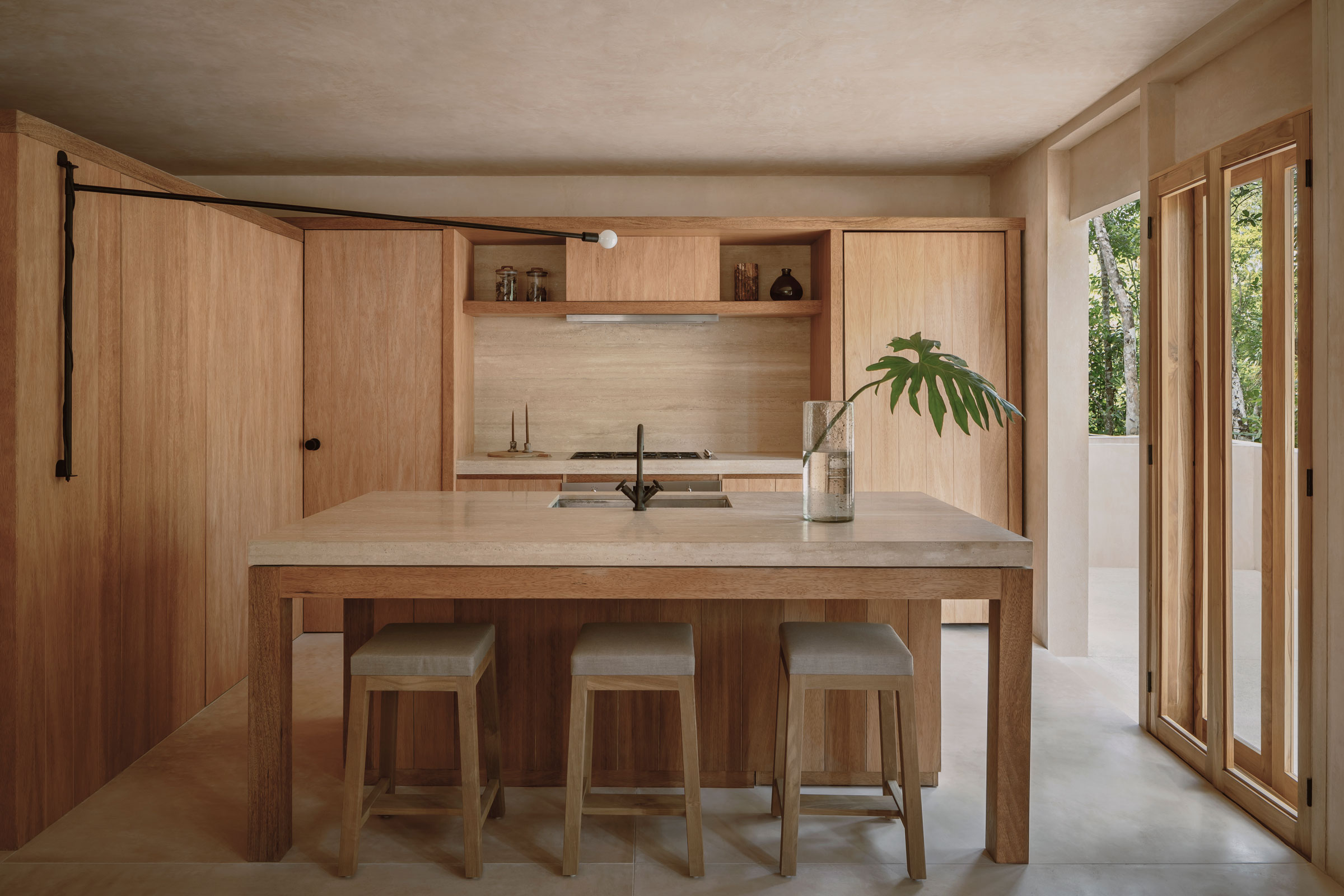
Candela residences feature eco-friendly materials, energy-efficient walls and windows, and a structured layout to maintain a light carbon footprint. Photo by César Bejar
When most people think about energy efficiency they tend to think small—that is, they focus largely on energy-efficient appliances and systems. And while those features are part of the equation, they only scratch the surface of true energy efficiency.
In reality everything from the location, orientation of the home, layout, materials used, and, yes, the systems and appliances installed are taken into account when designing for energy efficiency.
The Casa Candela Villa in Mexico, designed by Macías Peredo Architecture Studio, for example, utilizes natural shading from nearby trees, adequate ventilation, three-layered windows, and thick walls to help regulate interior temperatures without the excessive use of mechanical heating and cooling systems.
Over the last couple of decades energy-efficient homes have become more and more popular, in large part due to their lower operating costs, higher property values, and decreased environmental impact.
Why is an Energy-Efficient Home Important?
Aside from the fact that energy-efficient homes help homeowners save money, energy-efficient homes provide a wide range of additional benefits, including increased comfort, higher property values, energy security and resiliency, and more.
But the real reason energy-efficient homes are important lies in that they have a smaller environmental impact than conventional homes; they use less energy and generate fewer greenhouse gas emissions, resulting in fewer airborne pollutants. On average energy-efficient homes use 20 to 30% less energy than traditional homes, with some even producing a portion of their own energy by way of renewable sources.
Benefits of an Energy-Efficient Home
When it comes to home-buying and homebuilding, energy efficiency has become an increasingly desirable feature, in large part thanks to the wide range of benefits it entails.
Reduced Energy Costs
Predictably the most significant benefit of an energy-efficient home is the reduction in energy-related expenses. The average energy-efficient home saves up to 25% on utilities compared to similar homes that weren’t designed with efficiency in mind, according to the US Department of Energy.
Increased Comfort
Most energy-efficient homes are designed to naturally regulate interior temperatures throughout the year, making them more comfortable to live in during the hottest and coldest months. What’s more, energy-efficient homes are also typically much better than their non-efficient counterparts at maintaining a uniform indoor climate, reducing the likelihood of cold-spots, drafts, and the like.
The Urban Frontier House in Billings, Montana, for example, was designed by High Plains Architects to be extremely energy-efficient and passively regulate interior temperatures without the aid of mechanical systems. Features like a super-insulated envelope, natural ventilation, blinds, and a heat recovery ventilation unit allow the home to remain comfortable year round even as outside temperatures soar to 108℉ in summer and plummet to -36℉ in winter—all without the aid of active heating or cooling.
Sustainable & Lower Environmental Impact
As it stands nearly 40% of the world’s carbon emissions are produced by the real estate sector. Making our homes and buildings more energy-efficient helps reduce their carbon footprint and limits the amount of carbon dioxide released into the atmosphere, which in turn helps reduce air pollution. Energy-efficient homes are also more sustainable because they typically incorporate some form of renewable energy—i.e. solar power—or, at the very least, greatly reduce the amount of non-renewable energy consumed during their life-cycles.
Improved Health & Indoor Air Quality
Despite the inclusion of filters in conventional HVAC systems, frequent usage of heating and cooling systems can aid in the circulation of dust, mold spores, and other small particulate matter that can cause or exacerbate respiratory problems. Energy-efficient homes, on the other hand, seek to reduce dependency on HVAC systems, thereby lessening the spread of airborne allergens and irritants.
Due to the fact that they emphasize airtight seals, which limit water and air leaks, energy-efficient homes are also less likely to develop moisture problems. This then decreases the likelihood of mold and mildew growth, both of which can lead to the development of respiratory illnesses.
Increased Home Value
Homes rated as energy-efficient sell for 2.7% more than comparable unrated homes, according to studies conducted by the Federal Home Loan Mortgage Corporation. If that’s not beneficial enough, energy-efficient homes also tend to sell faster than their non-efficient counterparts. This really shouldn’t come as a surprise. After all, energy efficiency saves a homeowner money in the long run, which means prospective buyers are willing to pay more upfront in anticipation of future savings.
Less Maintenance
Energy-efficient homes that make extensive use of passive solar design elements and natural ventilation systems typically require less maintenance than non-energy-efficient homes, as they generally feature fewer mechanical/moving parts that wear down over time.
This isn’t to say that energy-efficient homes don’t require any maintenance. Preventative maintenance is integral to keeping an energy-efficient home running at peak efficiency. Overall, however, the type of maintenance energy-efficient homes require is typically less labor-intensive and cheaper than it is for non-efficient homes.
Resilience in Power Outages
Due to the fact that energy-efficient homes are designed to regulate temperatures naturally, with as little aid from mechanical heating and cooling systems as possible, they tend to have better resiliency in the face of power outages, particularly those that occur during the cold winter months.
This is especially true of energy-efficient homes equipped with on-site renewable energy features—e.g. solar panels—which can help supply power to the most crucial systems.
Materials That Make a Home Energy-Efficient
There are countless building materials that can aid in a home’s overall energy efficiency, either due to their high thermal mass or natural insulating properties—some of the most sustainable include:
Cork
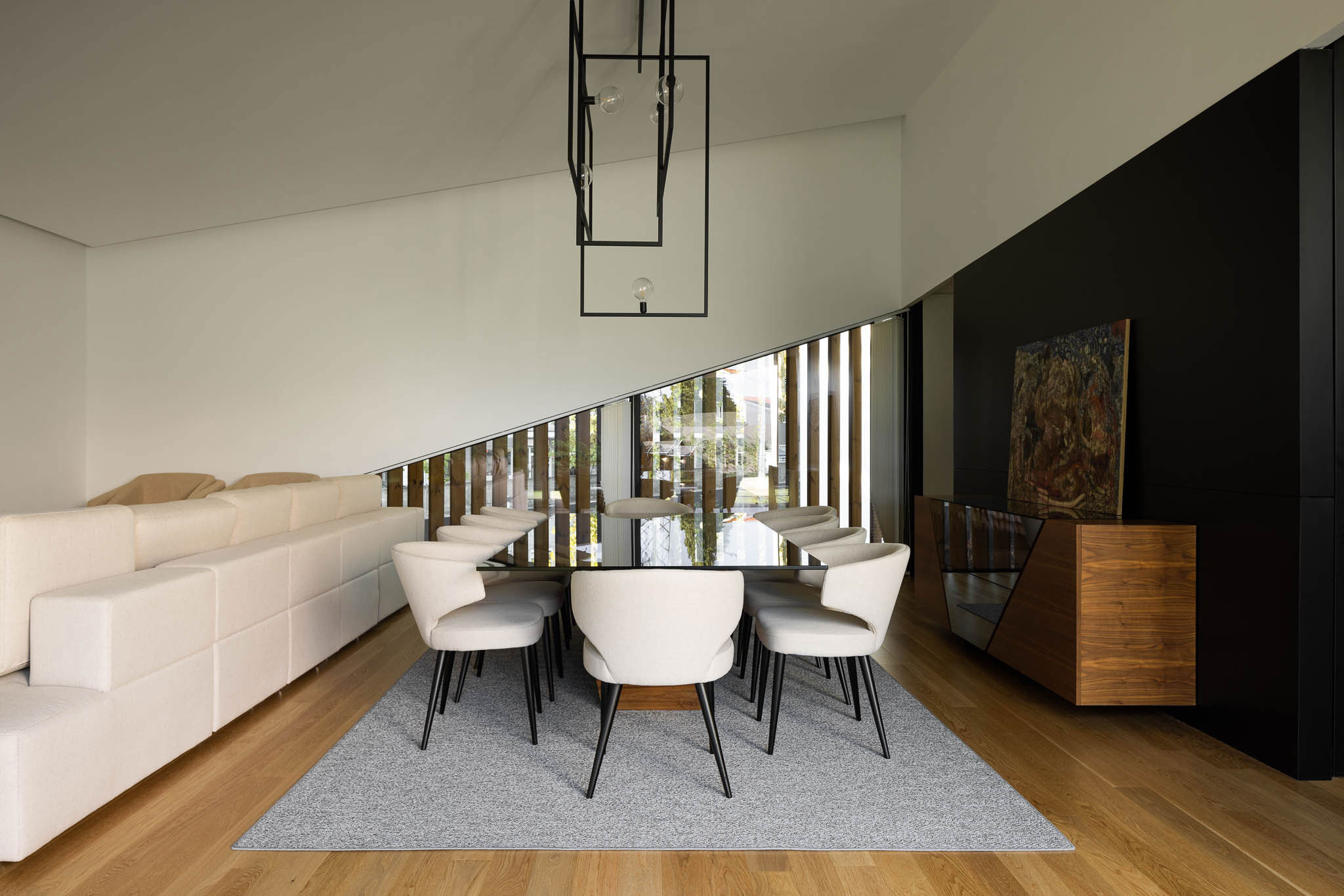
Lustrous flooring made largely of cork creates a cozy feeling. The cork is not only a more sustainable option, but a natural insulator as well. Photo by Ivo Tavares Studio
Similar to wood, cork is a natural insulator with low thermal conductivity. This makes it an excellent material for creating energy-efficient flooring and insulation. When used as flooring, cork has an R-value of 1.12, which is higher than that of vinyl, linoleum, bamboo, and virtually all soft- and hard-woods.
Cork can also be shredded and compressed into sheets to be used as insulation panels. With a thermal resistance of R-3.6 to R-4.2 per inch, cork insulation panels offer a better value range than traditional fiberglass batts, thereby reducing the need for mechanical heating and cooling systems. This was one of many reasons why Mutant Architecture chose cork flooring when designing the Tilt House in Portugal.
Cork is highly sustainable, as it only requires the bark from cork oak trees be harvested, rather than the tree itself. When done correctly harvesting cork bark does not harm the tree and regrows to sufficient levels every nine years.
Straw Bales
Straw bales have been used in US construction since the late 1800s and feature prominently in Nebraska architecture. This is largely due to that, when compacted into tight bales, straw is both fire-resistant and acts as an excellent thermal insulator.
It is straw’s insulative properties that make it an energy-efficient material, as it helps hold heat for longer periods of time during the winter months.
Insulated Concrete Forms

ICF walls provide improved insulation over traditional wood-frame buildings, thereby reducing heating and cooling loads. Photo courtesy of ICFMA
While concrete may not be everyone’s preferred aesthetic when it comes to home design, insulated concrete forms (ICFs) are extremely energy-efficient and can drastically reduce a household’s monthly energy expenses.
Strong, quick to manufacture, and relatively simple to put in place, ICFs are created by pouring concrete into insulated polystyrene foam forms. Once the concrete sets, the forms are left in place rather than removed, giving the wall improved insulating qualities over traditional wood-frame walls.
“You can have a structural wall that delivers between an R-45 and R-55 with no more investment in materials and less investment in labor,” Brian Corder, marketing chair for the ICFMA and president of BuildBlock, previously wrote for gb&d. “If you want to design a building that will deliver extremely high energy performance, ICFs offer all of this and more.” On average, ICF walls reduce a home’s heating needs by 44% and cooling needs by 32%.
Recycled Steel
While recycled steel itself doesn’t offer much when it comes to temperature regulation—it doesn’t conduct heat very well and isn’t a good insulator—it is incredibly strong. When used as a housing framework, recycled steel can support heavier amounts of insulation (be it wool, cellulose, stone wool, etc.), which makes it easier to maintain comfortable interior temperatures without the aid of mechanical heating and cooling.
Recycled steel sheets can also be painted with a reflective coating and used to construct cool roofs, or roofs that reflect more solar heat than conventional roofs, which typically absorb heat—and even unpainted metal roofs reflect solar energy better than asphalt shingles. Studies have shown that cool roofs can help reduce a home’s energy usage by anywhere from 7 to 15%.
Rammed Earth
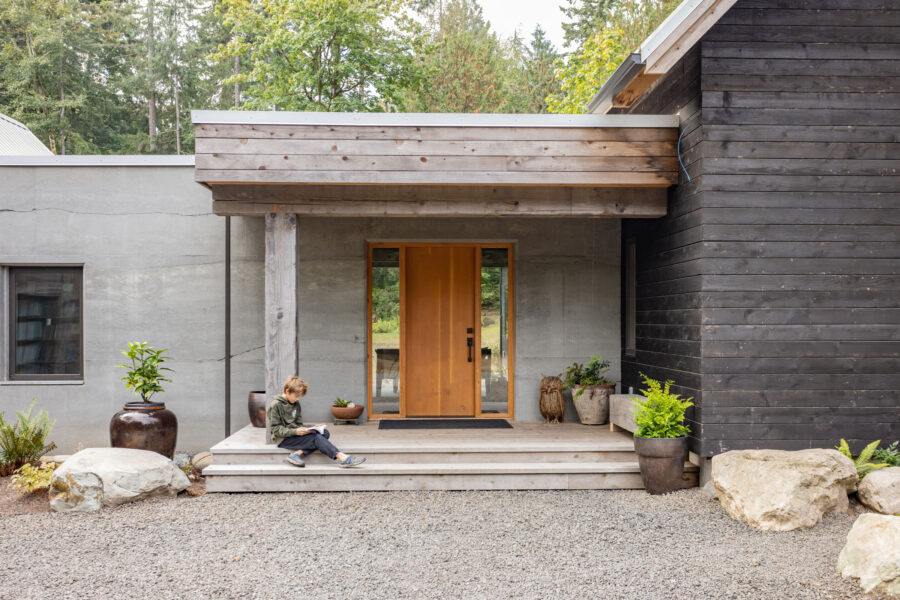
The Silver Rock residence on Bainbridge Island is a Living Building designed by McLennan Design that makes use of rammed earth in its construction. Photo by Emily Hagopian
There’s a reason rammed earth has been used to construct dwellings for thousands of years in a variety of environments; its thickness and high thermal mass make it excellent at regulating interior temperatures without the need for excessive HVAC usage.
This isn’t to say rammed earth constructs don’t benefit from insulation. Insulation is generally recommended for rammed earth walls, as it helps provide an added layer of regulation during long stretches of hot or cold temperatures.
The Silver Rock Living Building Home, designed by McLennan Design, utilized insulated rammed earth walls in its construction. “The rammed earth wall utilized SIREWALL technology that features insulation in between two steel-reinforced wall sections, creating an energy-efficient and durable construction that is beautiful and creates a feeling of solidity and permanence,” Jason McLennan, principal at McLennan Design, previously wrote for gb&d.
Rammed earth is also extremely compacted when used for home-building, which means air won’t leak through the walls and force your HVAC system to work harder.
How to Make Your Home More Energy-Efficient
Now that we’ve explored the basics of energy efficiency, let’s take a look at a few of the ways you can make your home more energy-efficient.
Upgrade Your Insulation
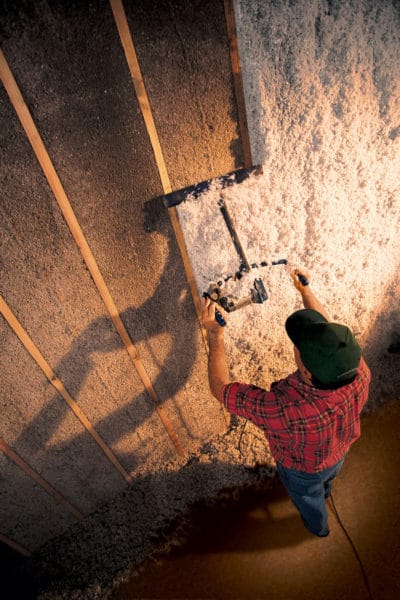
Greenfiber’s wall insulation starts as a plant material, is made into paper, and reused as insulation. Photo courtesy of Greenfiber
Most new homes are insulated with fiberglass insulation—and while fiberglass insulation has a fairly high R-value (2.2 – 2.7 per inch), there are better insulators out there. Stone wool insulation, for example, has an R-value between 3.0 and 3.3 per inch, while cellulose insulation has an R-value of 3.2 – 3.8 per inch—and both are more sustainable than fiberglass, too.
“Greenfiber uses a low-energy manufacturing process that results in materials with the least-embodied energy of most major insulation products. The production process generates little no waste or byproducts because we leverage recovered material to start with,” Jason Todd, the director of market development and building science at Greenfiber, previously told gb&d.
By upgrading your insulation, you reduce the amount of heat loss and gain throughout the year, which in turn minimizes the energy spent on heating and cooling your home.
Install Energy-Efficient Appliances
One of the simplest ways to improve your home’s energy efficiency is to install energy-efficient appliances, or any appliance that uses less energy than its traditional counterpart. Nowadays, energy-efficient alternatives exist for just about any major appliance you can think of: dishwashers, washing machines, dryers, refrigerators, ovens, stoves, etc.
In the US appliances with an ENERGY STAR label have been deemed energy-efficient according to standards set by the US Department of Energy or the EPA.
Seal Air Leaks
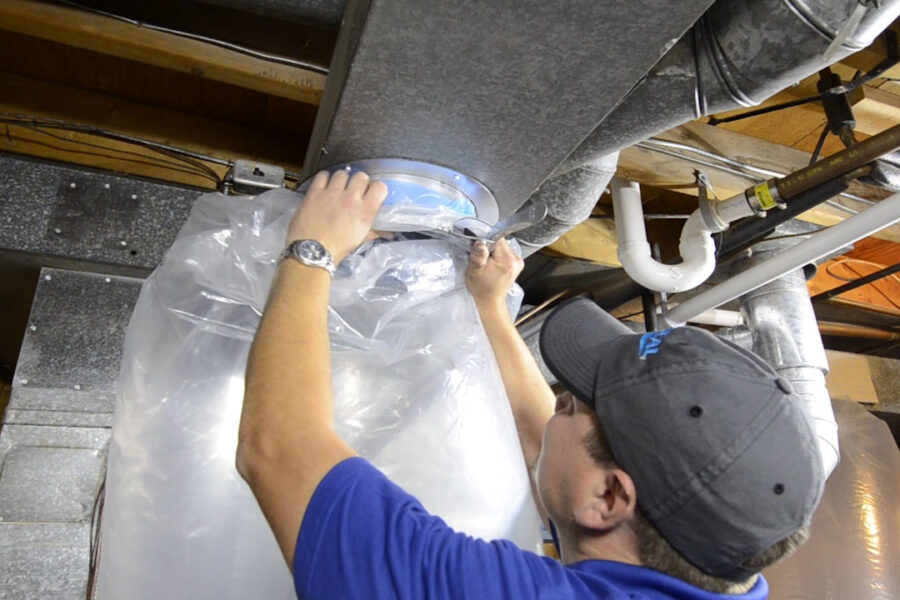
Air-sealing your home—and especially your ducts—can help improve energy efficiency and reduce energy waste. Photo courtesy of Aeroseal
According to Energy Star, air leaks account for roughly 25% to 40% of the energy used to heat and cool a home; these leaks don’t just waste energy, but also drastically reduce the effectiveness of other energy-saving features. By ensuring that all seals around windows, doors, and other potential openings are airtight, you’ll minimize the amount of heat lost during the winter and heat gained during the summer.
One area that shouldn’t be overlooked when sealing your home, however, is the ductwork. Leaky ducts waste conditioned air, creating inconsistent temperatures and causing your HVAC system to work harder to make spaces comfortable. Sealing ductwork in existing homes has, historically, posed quite the challenge as ducts are typically located in areas that are difficult to access. Fortunately, Aeroseal—a leading provider of innovative air-sealing solutions—has devised a means of sealing even the most inaccessible ducts.
“We pressurize the duct system and blow in micro-sized particles of a water-based sealant like a fog. Those particles find all the cracks and leaks within the duct system and seal them, so we’re sealing ducts from the inside out,” Maggie McCarey, head of policy and market development at Aeroseal, told gb&d in a previous interview. “We’re able to reduce leakage by 90% on average, which translates to about a 20% energy savings for the average home.”
Plant Trees Strategically
An easy way to passively reduce the amount of solar heat your house receives in the summer—while still allowing for maximum solar heat in winter—is to strategically plant trees near the home.
Planting deciduous trees alongside all west- and east-facing windows, for example, can help provide shade during the warmer months while still allowing solar energy during the winter months once the leaves have all fallen. Well-placed trees can save up to 25% of the energy used to heat and cool typical households.
Use Programmable or Smart Thermostats
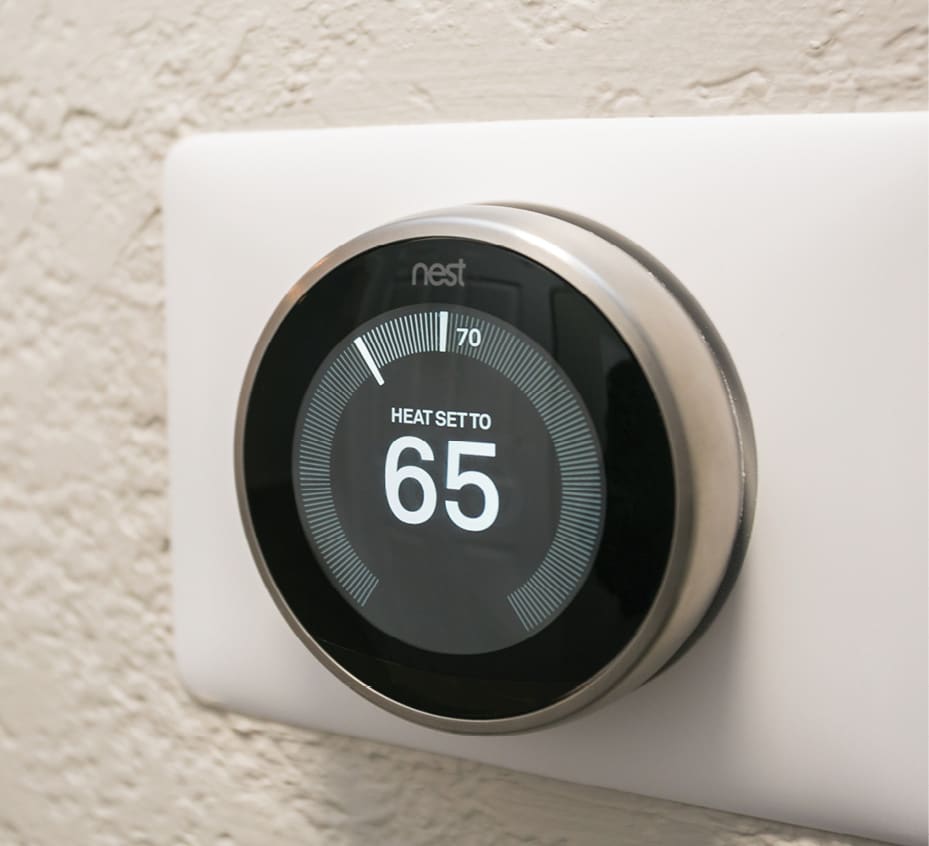
Photo courtesy of Nest
Instead of constantly turning your thermostat up or down or leaving it on while you’re not home, it’s in your best interest to install either a programmable or smart thermostat. When properly used, programmable thermostats—or those thermostats that can be set to a schedule—can save homeowners up to 10% on their heating and cooling costs.
Similarly, smart thermostats like those offered by Nest help save an average of approximately 12% on heating and cooling costs by using machine-learning to adjust to your household’s temperature preferences. “It’s always optimizing itself to meet your comfort demands and run the most efficient cycles,” Gene LaNois, general manager of the Professional Channel at Nest, previously told gb&d.
Opt for a Tankless Water Heater
Another way to reduce your home’s energy consumption is to install a tankless water heater rather than the traditional storage tank heater. On average tankless water heaters—which provide hot water on demand—use 24 to 34% less energy than storage tank water heaters in households that use less than 42 gallons of hot water per day.
If your household uses a large amount of hot water each day, the difference in efficiency between tankless and storage water heaters decreases, but tankless water heaters still remain the most energy efficient of the two.
Replace Your Light Bulbs With LEDs
One of the simplest ways to make your home more energy-efficient is to replace any existing incandescent and fluorescent light bulbs with energy-saving LED light bulbs. When lit, traditional incandescent bulbs waste a large portion of the electricity they use by generating heat as well as light—LEDs, on the other hand, produce very little heat and use approximately 90% less energy than incandescent light bulbs.
Because they do not possess a filament—the part that burns out in incandescent bulbs—or contain mercury vapor like fluorescent bulbs, most LEDs also last considerably longer than traditional lighting solutions, reducing maintenance requirements and waste.
Many architects and interior designers have begun prioritizing LEDs in recent years thanks to their durability and energy efficiency; the California House, for example, was designed by Gluck+ to be extremely low-energy and exclusively features LED lighting.
Install Energy Recovery Ventilators
Designed to work in conjunction with your HVAC system, energy recovery ventilators (ERVs) pull fresh air in from outside and send stale interior air outside via vents. During this process, ERVs do one of two things depending on the season; in summer ERVs recover heat from the incoming air and flush it back outside, whereas in winter, ERVs recover heat from the outgoing air and use it to warm the incoming air.
What this ultimately does is decrease the amount of energy needed for your HVAC system to heat or cool the air to the desired temperature. All in all, an ERV unit can help reduce your HVAC system’s energy use by about 50%.
Install Energy-Efficient Windows
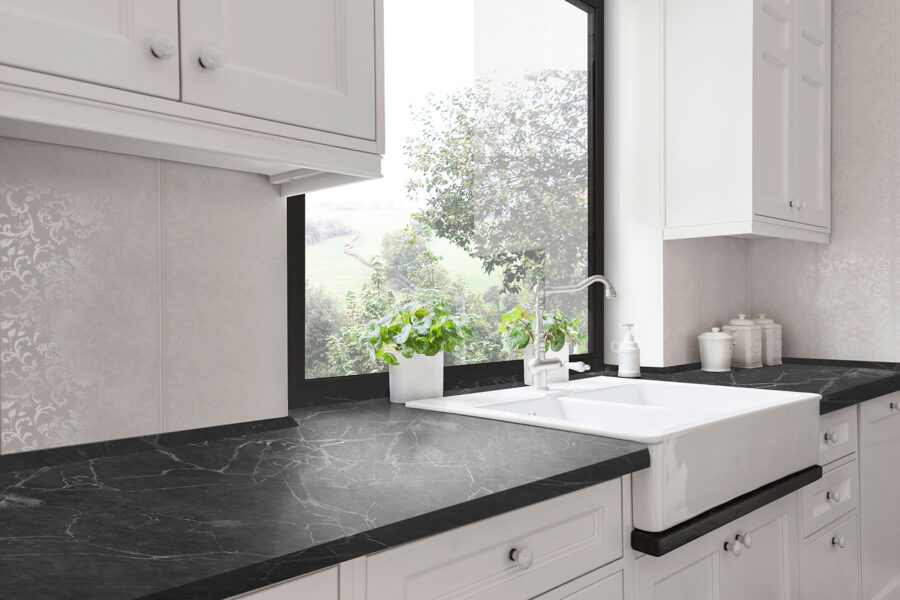
Black Thin Triple Insulated Glass Unit. Photo courtesy of PGT Innovations
According to the DOE, the heat gained and lost through conventional windows throughout the year is responsible for approximately 25% to 30% of a home’s heating and cooling energy. To minimize the amount of energy lost through windows, homeowner’s should install energy-efficient windows, or those windows with an ENERGY STAR label.
Windows can be made energy-efficient in two basic ways, with the most impactful being the addition of multiple layers of glazing. Adding additional panes of glass creates a cavity between each pane that can then be filled with an inert gas such as argon or krypton to improve the unit’s overall insulating capacity. Double-pane windows have long served as the industry standard, but triple-pane windows provide even greater efficiency—and companies like PGT Innovations are working to make them more accessible.
PGT Innovations’ revolutionary Thin Triple Insulating Glass Unit is designed to be an easy “drop-in” upgrade for window manufacturers, allowing for compatibility with most existing window frames. “Less than 5% of windows sold in the US today are triple pane units, so most window frames are not able to a fit a triple-pane unit,” Bob Keller, senior vice president of product innovation and technology at PGT Innovations, previously told gb&d. “With our Thin Triple IGU technology, most windows will be able to drop in a triple without changing the rest of the window. This will give end customers significantly more options for meeting their higher energy efficient needs.”
In addition to insulated glass, the thermal efficiency of windows can also be improved through the use of low-emissivity glazes and coatings. Low-E coatings contain microscopic metallic particles that reflect UV rays and prevent excess solar heat gain while still allowing natural light to filter through.
Install Ceiling Fans
As a general rule ceiling fans use significantly less energy than traditional air conditioning units. On average they use 99% less energy than a central AC system. Until outside temperatures crest 95℉, ceiling fans are capable of keeping interior temperatures at a comfortable level.
Most ceiling fans are reversible and are capable of drawing air upwards as well as pushing air downwards—by reversing your ceiling fans during the winter, it can actually help to disperse warm air (which rises) more evenly throughout a room.
Add Solar Panels
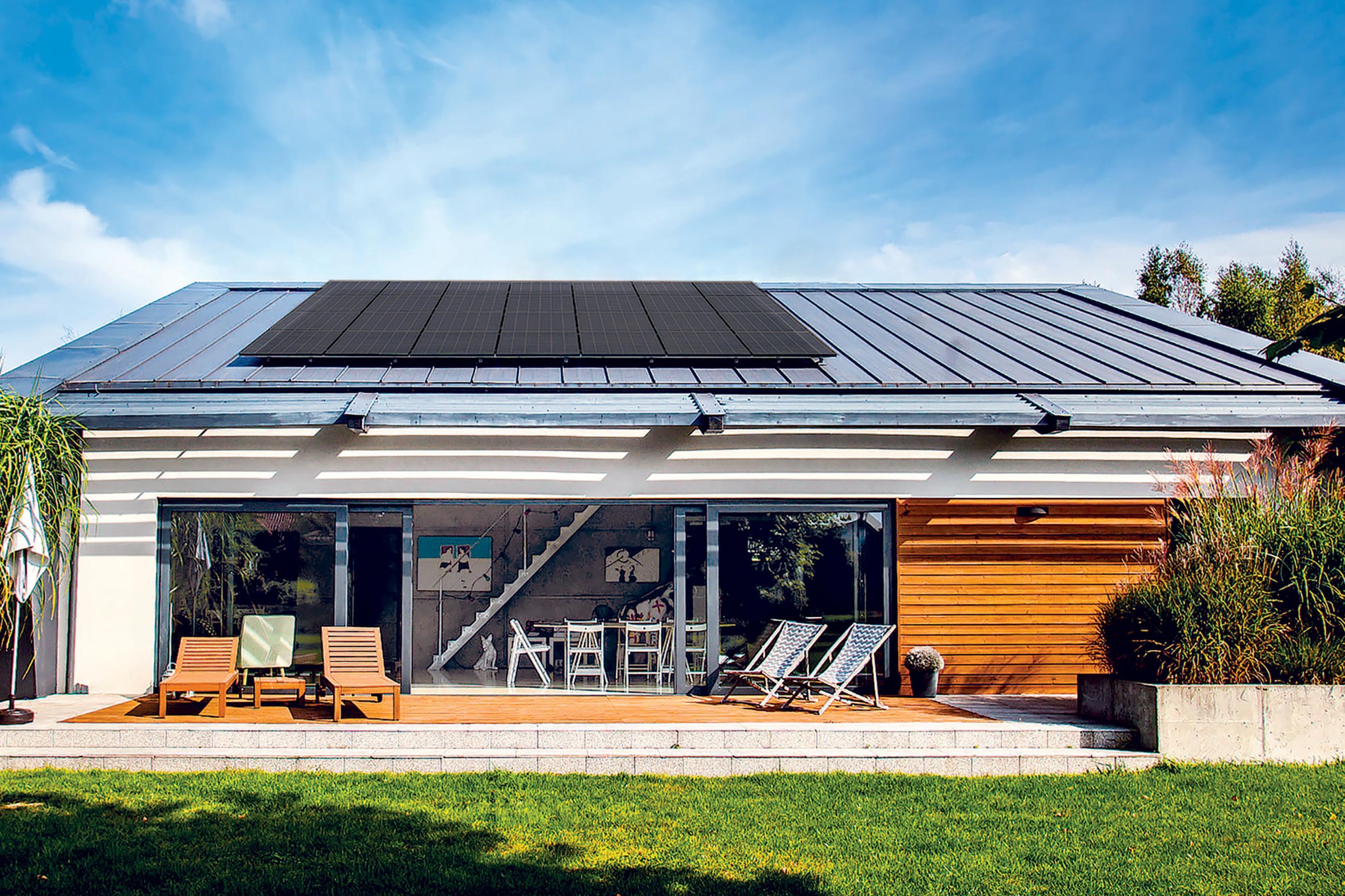
Q Cells considers its Q.PEAK DUO the BMW of solar. It is highly efficient yet cost-effective. Photo courtesy of Q Cells
While solar panels—or any other forms of renewable energy, for that matter—aren’t required for your home to be considered energy-efficient, they do provide improved energy security and reduce your home’s dependency on the energy supplied by power companies. The effectiveness of solar panels, however, depends on a number of factors.
“To get the most out of solar panels you need proper planning, design, and installation. The property needs to be inspected to determine the sun’s path and potential shade structures,” Ralph Alvarado, manager for PV Products at Q Cells—one of the leading producers of highly-efficient solar panels—previously wrote for gb&d. “The roof needs to be properly configured for optimal energy collection.”
Depending on how much power your solar panels are capable of generating—along with how much of that power you actually use—you may even be able to sell a portion of it back to the grid.
Regular HVAC System Maintenance
Like any mechanical system, your home’s HVAC is subject to routine wear and tear—coils build up grime, connections loosen, air filters get clogged, etc. If these things go unchecked, it can result in your HVAC system having to work harder to provide cool or warm air, which ultimately requires more energy.
To ensure your HVAC system is operating at peak efficiency, it should be inspected and serviced regularly. Most professionals recommend performing regular maintenance checks at least twice per year, towards the end of spring and autumn.
Use Blinds to Prevent Heat Gain
If you aren’t able to strategically plant trees to limit the amount of solar energy that comes through your home’s windows, interior and exterior blinds are your next best option. According to the DOE, blinds can help reduce indoor heat gain during the summer by as much as 45%, whereas curtains can help reduce heat gain by approximately 77%. In the winter, curtains drawn at dusk can help reduce heat loss by roughly 15% and blinds help prevent heat loss to a marginal degree.
When Ben Callery Architects redesigned a terrace house in Melbourne, for example, they elected to install remote-controlled operable external blinds and insulated thermal internal blinds from Sunway Cellular to help provide flexible control over daylighting, privacy, and solar heat gain.
Energy-Efficient Home Tax Credits
Aside from lower utility bills, energy-efficient homes can also help you save money in the form of tax credits. If you make certain upgrades—such as those defined above—after January 1, 2023, you may qualify for a tax credit up to $3,200, claimable for improvements made through 2032.
The credit equals 30% of certain qualified expenses, including energy efficiency improvements, residential energy property expenses, and home energy audits. The maximum credit you can claim each year is $1,200 for energy property costs and certain energy-efficient home improvements, and $2,000 per year for qualified heat pumps, biomass stoves, or biomass boilers.
This credit has no lifetime dollar limit and you can claim the maximum annual credit every year that you make eligible improvements until 2033. It should be noted, however, that this credit is only applicable to your main home—that is, where you live most of the time—and not to rental or other properties.




